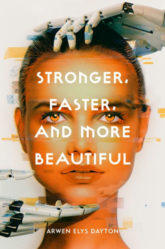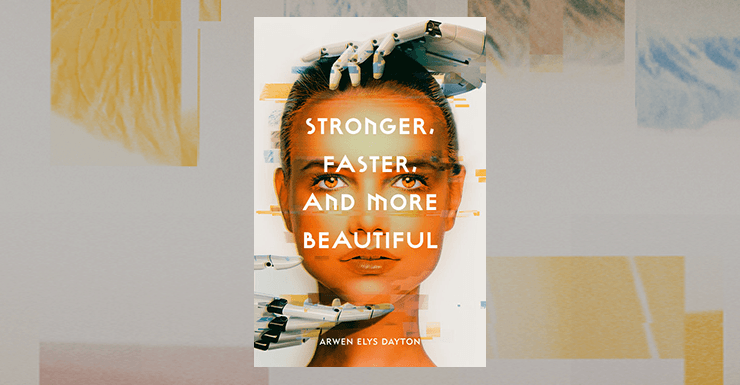I’m still not quite sure what to make of Arwen Elys Dayton’s Stronger, Faster, and More Beautiful, out from YA imprint Delacorte Press. It feels less like a novel than a series of snapshots of a future in which humans have started to intensively modify themselves—first in life-saving surgeries, then expanding to increased intelligence and things like gills, culminating in a vast and diverse array of modifications and a society in North America which sets aside reservations for “Protos”—original, unmodified humans.
The last time I read a novel which provided a set of snapshots of a future and which actually worked both as a mosaic novel and as individual stories within that mosaic was over a decade ago now. The novel was Charlie Stross’s magisterial Accelerando, one hell of a long-form debut, and one which has coloured my view both of mosaic novels and of novels which are engaged in the project of futurism ever since.
Stronger, Faster, and More Beautiful divides itself into six parts. Each part centres on a different main character, and each is set in a different context, as the timeline extends further into the future. (The furthest future depicted in the book still remains within five or six generations of the present day.) Part One, Part Two, and Part Four are told from a first-person perspective, from the point of view respectively of a teenage boy who is about to have his twin sister’s organs and body used to save his life; a teenage girl in a religious school who has had a similar life-saving operation, keeps the extent of her reconstructive surgery from her classmates, and who’s humiliated by her date after her first sexual experience; and an intensively modified non-neurotypical pre-adolescent employee of a company specialising in modifications, who lives and works among dolphins and manatees. Part Three, Part Five, and Part Six are told from a tight third-person perspective, starring respectively Elsie, the daughter of a preacher who was once intensely anti-modification and who converted just as intensely to the pro-modification side once his own family’s lives were at stake; Jake, a cryogenically frozen and then reanimated American teenager who ends up as an intensively modified Russian slave, who escapes with the aid of a fellow slave, a gay Russian teenager; and Luck, a “Proto” (an unmodified human) living on a reservation and who witnesses the moment—and the immediate aftermath—when modified human society begins to collapse from a spreading virus that kills everyone who contracts it.
These six separate parts are more slice-of-life vignettes than self-contained stories that together add up to a great whole, and this is one of the enduring frustrations of Stronger, Faster, and More Beautiful: Not only is it not unified by character or by a traditional overarching plot, but thematically it also strikes me as somewhat incoherent. The first three sections are explicitly religiously-inflected, treating the question of whether extensive human modification is according to “God’s plan” (in a context where the only god discussed is a Christian god, and a god very much in the tradition of American evangelical religion) as a key part of each section. The latter three sections, on the other hand, move away from a religious treatment of human modification to focus on how the new developments in science and society are used in exploitative ways, culminating in a collapse and a “return to nature.” The thematic arguments throughout aren’t carried through in either particularly coherent or particularly compelling ways.
Buy the Book


Stronger, Faster, and More Beautiful
Stronger, Faster, and More Beautiful also does the thing that a lot of American near-future science fiction does: It sees the world outside of the United States (and, perhaps, one or two major competitor powers, in this case Russia) largely as an irrelevance. All of its main characters originate within the present-day United States, and the politics of the rest of the world feel much more like an afterthought. (Although, unlike many examples of American near-future science fiction, there’s a little consideration of explaining why the rest of the world doesn’t impinge too much on the narrative.)
The prose is solid, and the book as a whole is easy to read. But there’s no compelling character arc or overall plotline, and I’ve seen similar themes treated in far more interesting ways—ways that had a lot more emotional impact—several times before. From my point of view, there’s just not an awful lot of there there, to be honest. Which makes for a frustratingly and ultimately unsatisfying read.
Stronger, Faster, and More Beautiful is available from Delacorte Press.
Liz Bourke is a cranky queer person who reads books. She holds a Ph.D in Classics from Trinity College, Dublin. Her first book, Sleeping With Monsters, a collection of reviews and criticism, was published in 2017 by Aqueduct Press. It was a finalist for the 2018 Locus Awards and was nominated for a 2018 Hugo Award in Best Related Work. Find her at her blog, where she’s been known to talk about even more books thanks to her Patreon supporters. Or find her at her Twitter. She supports the work of the Irish Refugee Council, the Transgender Equality Network Ireland, and the Abortion Rights Campaign.










